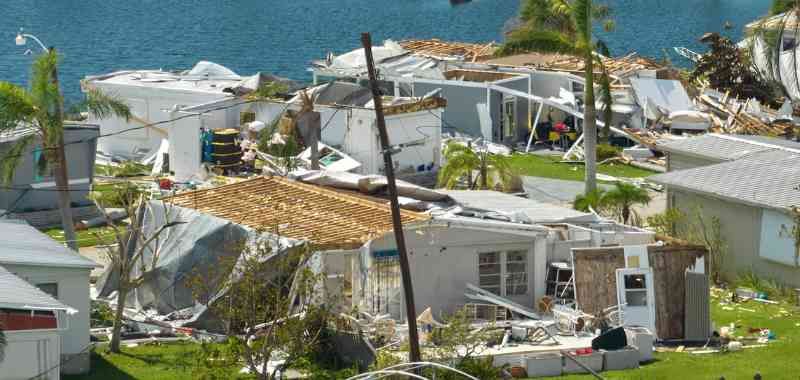
Email: jberger@ertitraining.com
Phone: 541-740-4241
Hurricanes and Hazmat Hazards Navigating the Perilous Aftermath
The dangers of hazardous materials following hurricanes are clear and present. For emergency responders, environmental safety professionals, and local authorities, understanding these risks is crucial.

Hurricanes are nature's most formidable forces, leaving devastation in their wake. While the immediate impacts—flooding, wind damage, and power outages—are well-known, an often-overlooked danger lurks in the aftermath. The release of hazardous materials, or hazmat, poses serious threats to public health and safety. This blog post dives deep into the hidden dangers of hazmat following hurricanes, a critical issue for emergency responders, environmental safety professionals, and local authorities.
Understanding Hazmat Dangers from Hurricanes
What are Hazardous Materials?
Hazardous materials come in many forms, including chemical, biological, and radioactive substances. When these are released during a hurricane, they can contaminate air, water, and soil, posing long-term health risks. Common hazardous materials include industrial chemicals, petroleum products, and household cleaning agents.
Why Hurricanes Amplify Hazmat Risks
Hurricanes disrupt storage facilities, industrial sites, and homes, causing the release of hazardous materials. Floodwaters can spread these contaminants over large areas, making cleanup efforts more complex and dangerous. The combination of high winds and flooding compounds the risks, dispersing hazmat far and wide.
Historical Context and Real-World Examples
History provides sobering examples of hurricanes exacerbating hazmat dangers. Hurricane Katrina, for instance, caused widespread contamination in New Orleans, with oil spills and chemical leaks adding to the chaos. Similarly, Hurricane Harvey saw the release of toxic substances from flooded chemical plants in Texas, leading to fires and explosions.
Identifying Common Hazmat Threats
Industrial Chemicals
Industrial chemicals are particularly concerning during hurricanes. Facilities storing these substances may suffer structural damage, leading to leaks and spills. Examples include chlorine, ammonia, and benzene, all of which have severe health implications.
Petroleum Products
Petroleum products such as gasoline and diesel fuel are ubiquitous in urban and industrial areas. During hurricanes, storage tanks can rupture, and pipelines can break, resulting in extensive environmental contamination. These substances are not only flammable but also toxic to both humans and wildlife.
Household Hazmat
Even everyday household items become hazardous during hurricanes. Cleaning agents, paints, and batteries contain chemicals that can pollute water sources. When flooding occurs, these materials can mix and create dangerous chemical reactions.
The Role of Emergency Responders
Immediate Response Measures
Emergency responders are the first line of defense against hazmat dangers. Their immediate actions are crucial in containing and mitigating spills. This includes identifying the type of hazardous material, setting up containment zones, and initiating appropriate cleanup procedures.
Specialized Training and Equipment
Responding to hazmat incidents requires specialized training. Emergency responders must be well-versed in hazardous material identification, containment strategies, and decontamination processes. Equally important is the use of specialized equipment, such as hazmat suits, gas detectors, and containment booms.
Coordination with Local Authorities
Collaboration between emergency responders and local authorities is essential. Effective communication ensures that resources are allocated efficiently and that public safety measures, such as evacuations and advisories, are implemented promptly. Joint training exercises can enhance preparedness and coordination.
Environmental Safety Protocols
Pre-Hurricane Preparedness
Preparation is key to minimizing hazmat dangers. Environmental safety professionals can assess vulnerable sites and recommend measures to secure hazardous materials. This may include reinforcing storage tanks, elevating containers, and ensuring proper labeling.
Post-Hurricane Assessments
After a hurricane, thorough assessments are necessary to identify and mitigate hazmat risks. Environmental safety professionals conduct site inspections, sample soil and water, and analyze the extent of contamination. Their findings guide cleanup efforts and inform public health advisories.
Long-Term Monitoring and Remediation
Hazmat dangers do not disappear once the immediate cleanup is over. Long-term monitoring is crucial to ensure that contamination levels remain safe. Remediation efforts, such as soil excavation and water treatment, may be required to restore affected areas fully.
Community Awareness and Involvement
Educating the Public
Public awareness is a vital component of hazmat safety. Communities must understand the risks and know how to respond in case of exposure. Educational campaigns can provide information on identifying hazardous materials, safety precautions, and reporting procedures.
Encouraging Community Participation
Involving the community in preparedness and response efforts enhances overall resilience. Local volunteers can assist with monitoring, reporting spills, and supporting emergency responders. Community drills and workshops can foster a culture of readiness and cooperation.
Utilizing Social Media and Technology
Social media and technology play a significant role in modern disaster response. Platforms like Twitter and Facebook can disseminate real-time information about hazmat incidents. Mobile apps and online tools can help track contamination and provide guidance on safety measures.
Lessons from Past Hurricanes
Hurricane Katrina
Hurricane Katrina highlighted the severe impact of hazmat incidents. The extensive flooding led to numerous oil spills and chemical leaks, complicating the recovery process. The lessons learned emphasized the need for robust preparedness and swift response.
Hurricane Harvey
Hurricane Harvey's impact on chemical plants in Texas underscored the vulnerabilities of industrial facilities. The resulting fires and explosions demonstrated the importance of securing hazardous materials and having contingency plans in place.
Hurricane Sandy
Hurricane Sandy's aftermath revealed that even densely populated urban areas are not immune to hazmat dangers. Contaminated floodwaters affected residential neighborhoods, highlighting the need for comprehensive community education and involvement.
Future Trends in Hazmat Safety
Advancements in Detection Technology
Innovations in detection technology are enhancing hazmat safety. Portable sensors and drones equipped with gas detectors can rapidly identify hazardous substances, enabling quicker and safer response efforts.
Improved Training Programs
Ongoing advancements in training programs are equipping emergency responders with the latest knowledge and techniques. Virtual reality simulations and online courses offer accessible and effective training options.
Policy and Regulatory Developments
Policy and regulatory changes are shaping the future of hazmat safety. Stricter regulations on hazardous material storage and transportation aim to reduce risks. Collaboration between government agencies and private industries is driving improvements in safety standards.
Conclusion
The dangers of hazardous materials following hurricanes are clear and present. For emergency responders, environmental safety professionals, and local authorities, understanding these risks is crucial. By implementing robust preparedness measures, enhancing response capabilities, and fostering community awareness, we can mitigate these dangers and protect public health and safety.
The next step is up to you. Equip yourself with the knowledge and tools needed to face the hazmat challenges that come with hurricanes. Stay informed, stay prepared, and stay safe.
By integrating these insights, you can better protect your community and respond effectively to hazmat incidents. Remember, preparedness and education are your best tools in navigating the perilous aftermath of hurricanes.









